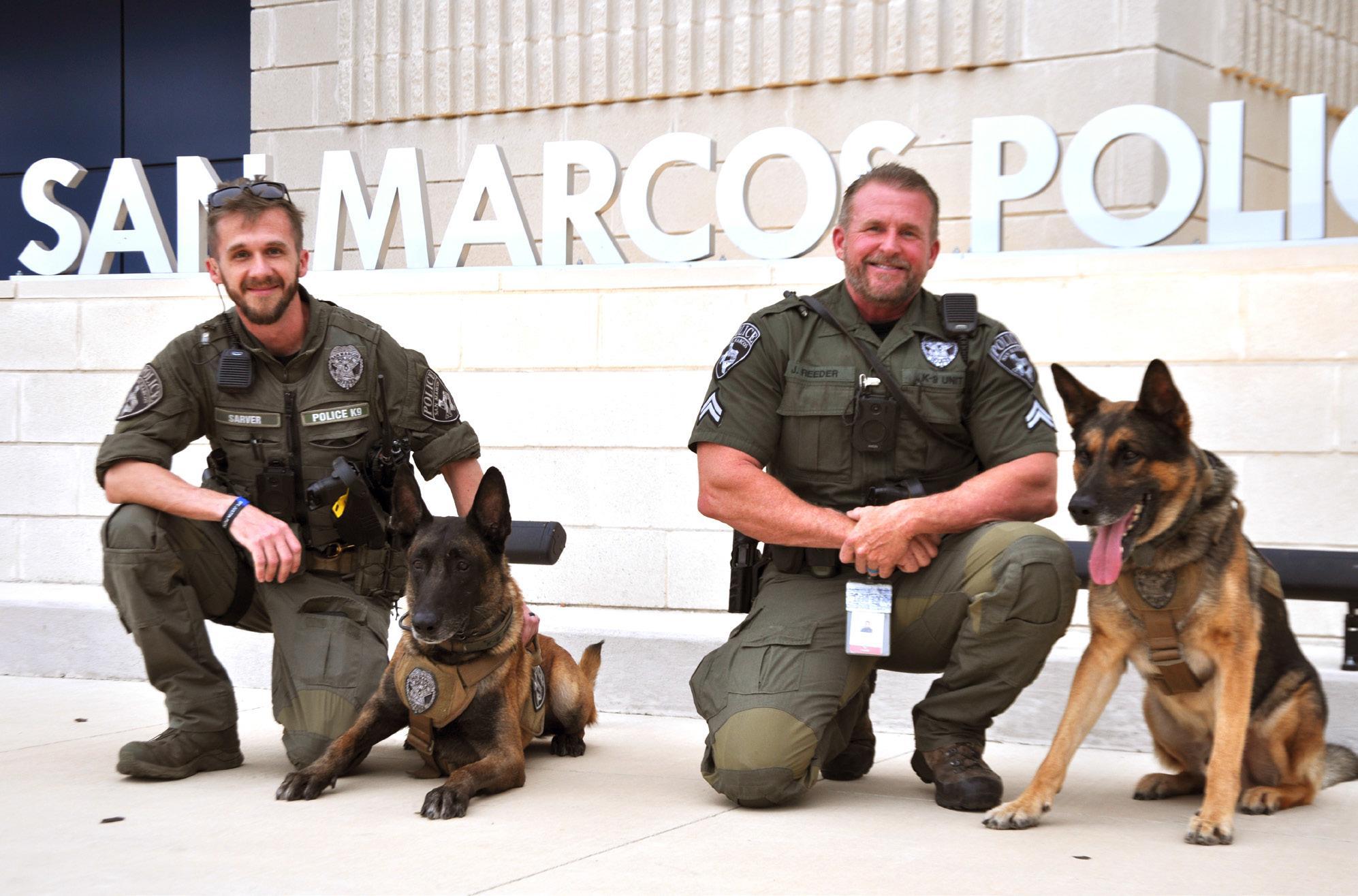
San Marcos Police Department has the two best K-9 units in the nation based on their 1st and 2nd place finishes in a recent association competition. From left, Officer Stephen 'Steve' Sarver and Rex, and Cpl. John Reeder and Max. Below, Max poses for his top dog day.
Daily Record photos by Barbara Audet
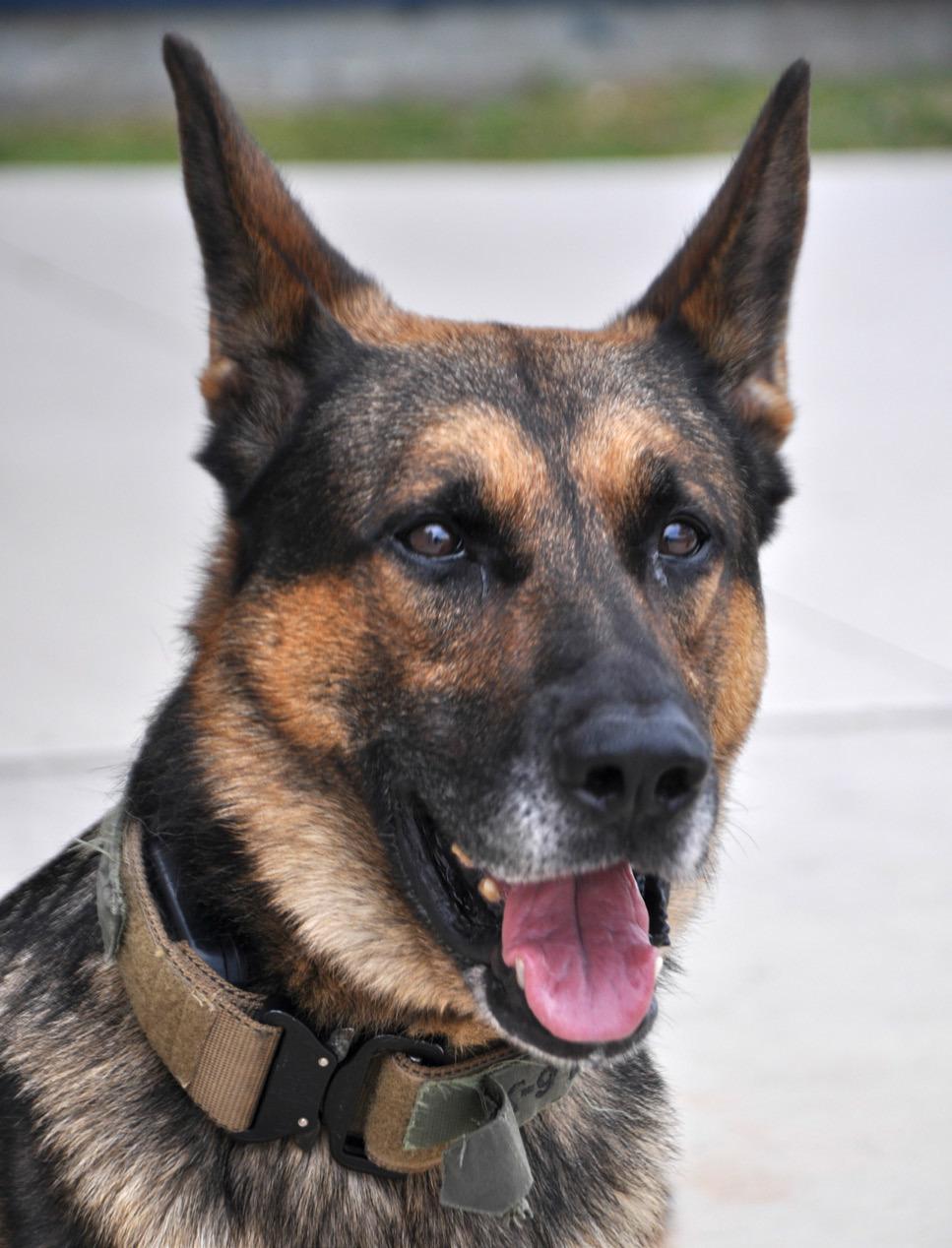
Max
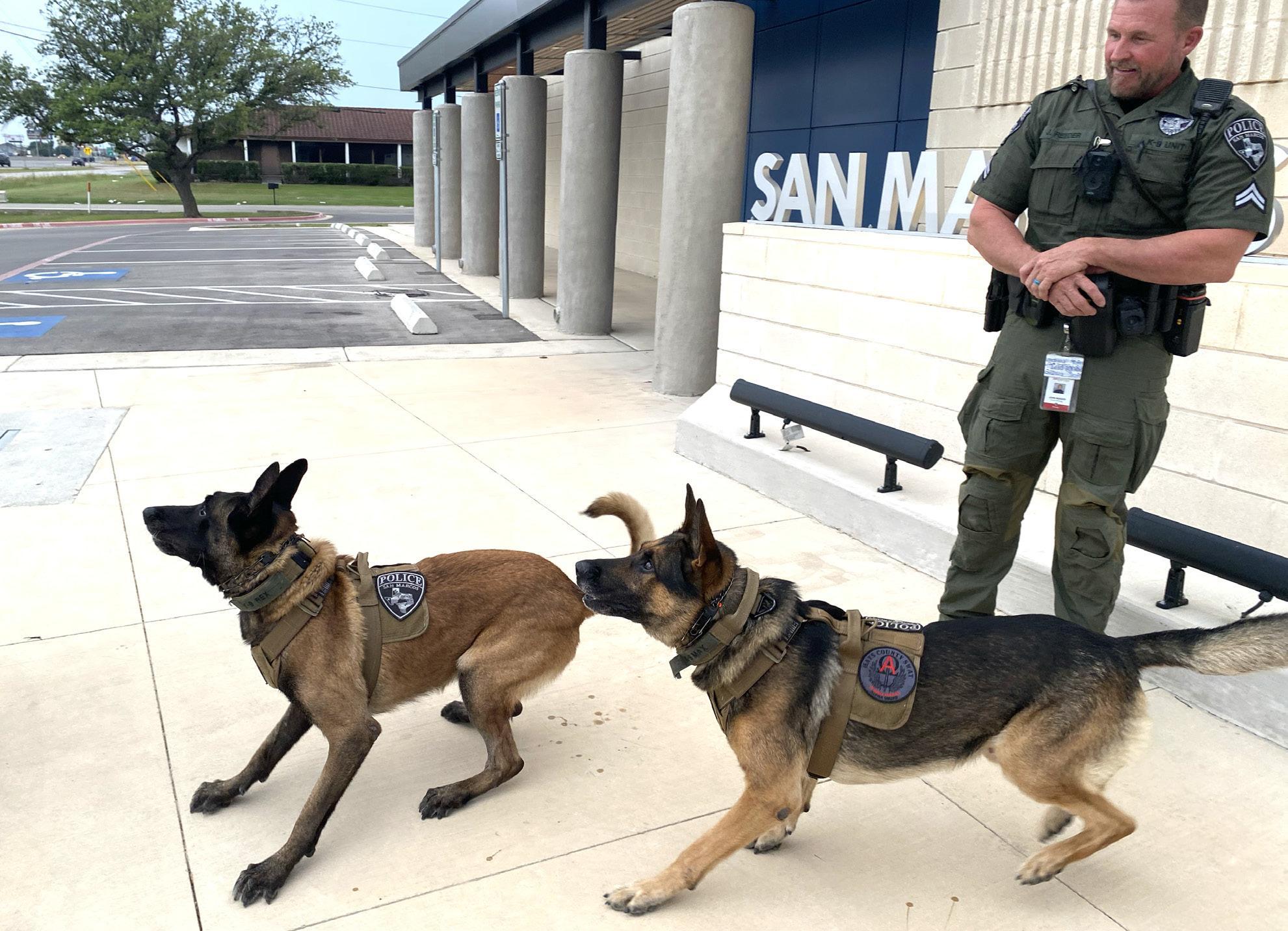
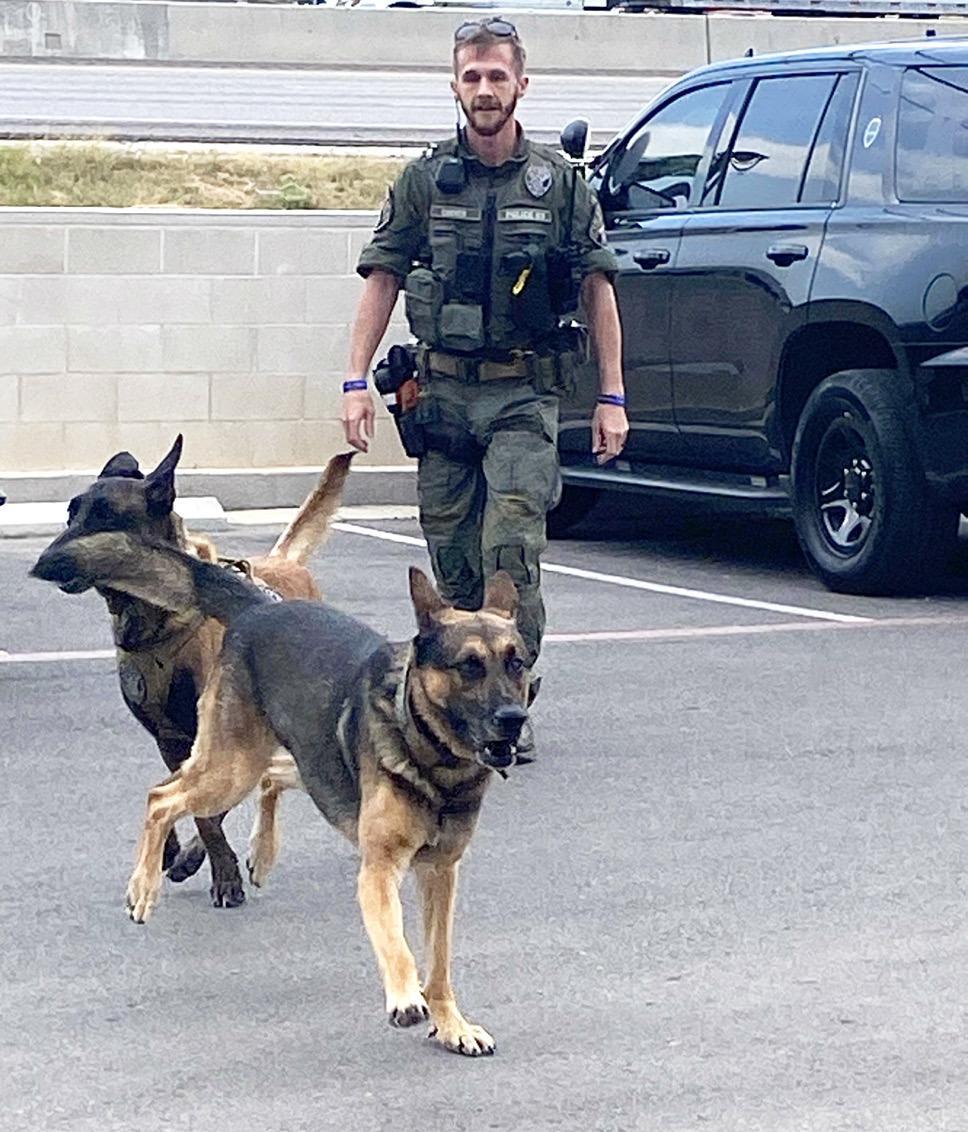
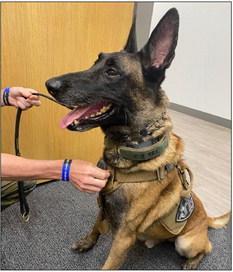
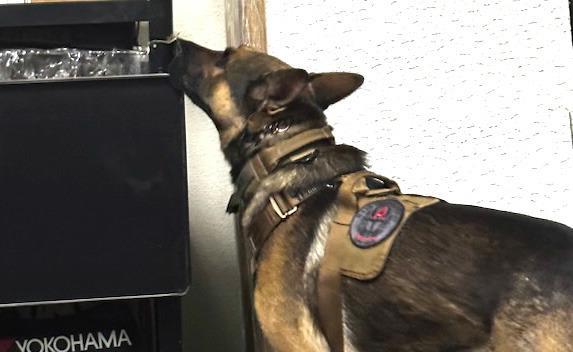
Top, Cpl Reeder with Rex and Max. Middle left, Officer Sarver with Rex and Max. Middle right, Rex is ready to train.
Daily Record photos by Barbara Audet
Above, in training at a San Marcos business, Max scopes out evidence.
Photo provided by SMPD Officer Steve Sarver
DOGGONE GREAT
San Marcos K-9 teams bring home top honors in nation
With a heat index on a intensely sunny June day of over 109 degrees, four members of the San Marcos Police Department–two of them with four feet each, wearing vests and insignia, were getting ready to head over to a local business for some weekly specialized training.
Of the four, the two with bright brown fur and expressions of attention and dedication, still just wanted to show off a bit and see which could get a hidden ball faster at the SMPD headquarters.
San Marcos Police Department Cpl. John Reeder and Officer Stephen “Steve” Sarver, with their K-9 partners, Max and Rex, are this community's heralded, loyal teams of man and dog.
Both Max and Rex are award-winning canines that can smell out heroin, cocaine, meth, ecstasy or marijuana at the direction of their handlers/team members in that quintessential blink of an eye.
But at night, they head home with their teammates, and like any family dog, hunker down in their spot. Although Max with his 79 pounds can open “any door” in the house, Reeder said. He occasionally will get leftover treats but mostly he eats dry dog food. That is where any similarity to yours or anyone else's dog ends.
The difference for these animals, as opposed to a non-working dog, is that any moment they may be called to a disaster or emergency, and then, asked to respond without hesitation or retreat, to threats and dangerous situations. As shown by annual city statistics, these risks are all the more likely as Central Texas witnesses a growth in population that routinely brings more crime and violence here.
The officers and dogs recently competed with 15 other teams from across the country during the 2023 National Narcotics Detector Dog Association Conference held in Murfreesboro, Tennessee, May 29-June 2. For the four, it was an opportunity to demonstrate how much their regular training and a true commitment to having animals as part of the force does benefit a community the size of San Marcos and beyond.
Following a grueling competition, the scenario unknown to the teams until the time starts, the two teams brought home honors that declared them to be first and second in the nation for police service.
“It [the competition] changes every year ... they don't want you to be able to game it out,' Reeder said, noting there were two scenarios in 2023.
'This year, they did a basic call off where a bad guy takes off running. You send the dog to go get him. This guy gives up. Stops. You call the dog off before he gets there.,' he said.
The second scenario involved a vehicle in a livestock arena where Max and Rex were put through their paces and in each moment performed to the maximum expected for a handler/ canine team.
Max, 5, the older of the two, received an additional recognition: the Freddy Bouillon Award. This award is conferred on what the organization determines is the toughest dog in the competition– in their opinion, the premier police dog in the United States.
Both dogs were born in Europe–known for puppy programs that are well run and efficient. They were brought to the United States by Global K-9 in San Antonio, Reeder said.
Max is lovingly called a 'mutt,' a mixed breed with Belgian Malinois and German Shepherd lineage from Bosnia–his breeds are known for their service capabilities. Each dog came with a name, so negotiations there.
Reeder said not every dog has the ability or capacity to become a service dog and these imported pooches have a better chance at success.
“When you get them, you go through a handler school with them which is five to six weeks,” Reeder said, speaking in a deep voice reminiscent of a 1960s TV cowboy–a voice a dog might respect. “You’re basically learning to know the dog and you’re training with the dog at that time, too, going through the basic stuff. But to get them actually trained, it takes a couple of years to get them up to where you’d like them to be. They say the golden years are between three and seven. But it takes about three years before … they have it down pat.”
It seems a short amount of time for a service dog but what is condensed in that time saves lives.
The achievement of Reeder who essentially restarted the program from scratch, Sarver, Max and Rex represents a pinnacle in this work, because of that 50,000, Max is likely one of very few service dogs that can follow a laser on command in the field–a skill he and Reeder have worked on steadily together. From Houston, a U.S. Marine Corps veteran with 26 years in police work, Reeder said that Max has a high work ethic and is learning everyday.
“He is very well socialized, I could bring him in here and you could pet him,” Reeder said, and later, to confirm that, Max welcomed a scratch or two behind the ears. “He doesn’t mess with anybody unless I tell him to.” Rex is equally well socialized, he said.
'It takes a really special dog to be a police dog,' Reeder said. 'Even if you breed two really good dogs together, not all of the pups are going to make good pups,' for service work.
Knowing when a dog should be sent out and when they need to remain in an A/C-controlled vehicle is paramount in Texas, Reeder explained. These dogs, especially Max, will stay on point and work until you stop them–working until they dropped, and so, a relationship with a handler that supports the animal and understands quickly how to size up a dispatch call can protect an officer as well as his or her dog.
With high praise for Reeder who he called a 'myth and legend,' Sarver, whose career had stops in Pennsylvania and Maryland before choosing Texas, said that Rex’s personality empowers his keen narcotics and therefore, sniffing out abilities.
In response to being asked why he cares about his job so much, Sarver described one incident where Rex excelled at finding evidence and a suspect in connection to a stabbing that had occurred a couple of years ago under the Highway 80 bridge.
“The suspect had gone out somewhere in the woods and the victim was transported in an ambulance. We put up Rex to do a track. And we tracked in the dark, in the middle of the woods, and Rex found the knife that was used in the stabbing. Halfway through the track, he lays down on this knife … we get back and we keep going and we end up finding the suspect, Rex tracked back to the suspect,” he said. 'We never would have found this if it wasn’t for Rex,” he said, with all the pride of any dog owner. Human smell will dissipate off of a knife or a piece of evidence in a location such as the woods he referenced .and by finding it that night, Rex made an important contribution to the case.
The conference offered these teams workshops and the opportunity to renew their certifications, an annual practice. According to information on the NNDDA website, the organization began in 1978 in Nacogdoches with an emphasis on narcotics detection. There are in excess of 2,500 members from 28 states, as well as members in Mexico and Canada. There are other organizations that represent the work and service of K-9 officers, including the United States Police Canine Association. Estimates as to how many dogs suit up daily to serve towns, cities and counties, are approximately 50,000. Dogs are used for explosive detection, cadaver and missing persons searches and narcotics detection. Reeder said they are always looking for new locations to train, and welcome opportunities within the community where they may be granted access without interruption. To offer a site contact the SMPD.











